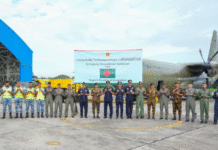Some 507,000 new arrivals of Myanmar’s fleeing Rohingya population are reported as of September 30, including 453,300 new arrivals identified in IOM’s Needs and Population Monitoring assessments in four upazilas of Cox’s Bazar district, says a new report on Sunday.
The latest figure includes 35,000 in refugee camps reported by UNHCR and 18,700 reported by field staff in Naikhongchhari (Bandarban district).
Over the last two days, movement across the border in Cox’s Bazar has reportedly decreased again, according to the report “Situation Report: Rohingya Crisis”.
The Inter Sector Coordination Group (ISCG), convened by the IOM, in collaboration with humanitarian partners prepared the report that covered September 21 – 27.
The next report will be issued on October 8, said the IOM on Sunday. Some 37% of refugees arrived by walking and 34% by boat.
People who have arrived since August 25 continue to move to the new Kutupalong Expansion site, where they are constructing new shelters.
The RRRC is leading on the Kutupalong Expansion project along with the Site Management Taskforce, which includes UNHCR, IOM and other key implementing agencies.
Some 20 ‘blocks’ have been identified by RRRC. Agencies continue to focus on delivering aid wherever people have settled. Road access continues to be a constraint for humanitarian assistance delivery, with road repairs underway.
As of now 630 meters of road construction has been completed in Balukhali.
The latest violence in Myanmar’s Rakhine State which began on August 25 has driven an estimated 436,000 Rohingyas across the border into Cox’s Bazar, Bangladesh.
The speed and scale of the influx has resulted in a critical humanitarian emergency. The people who have arrived in Bangladesh since 25 August came with very few possessions.
They have used the majority of their savings on transportation and constructing a shelter, often out of no more than bamboo and thin plastic. They are now reliant on humanitarian assistance for food, and other life-saving needs.
Basic services that were available prior to the influx are under severe strain due to the massive increase in people in the area.
In some of the sites that have spontaneously emerged, there is no access to water and sanitation facilities, raising the risks of an outbreak of disease.
The Rohingya population in Cox’s Bazar is highly vulnerable, having fled conflict and experienced severe trauma, and now living in extremely difficult conditions.
Population movements within Cox’s Bazar remain highly fluid, with increasing concentration in Ukhia, where the government of Bangladesh has allocated 2,000 acres for a new camp.
Source: The Daily Star









